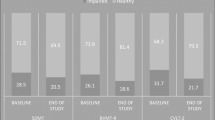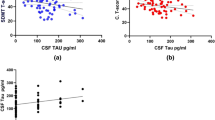Abstract
Background
Serum neurofilament light chain (sNfL) may be used as a biological marker of disease progression in multiple sclerosis (MS), although longitudinal studies correlating cognitive deficits to sNfL are limited.
Objective
To longitudinally investigate the relation between cognitive dysfunction, sNfL and MRI brain volume in a relapsing remitting MS patients.
Methods
18 MS patients (9 males and 9 females, mean age 45 years, mean education 12.6 years) all prescribed with interferon beta 1a (44 mcg 3 times per week), are longitudinally evaluated by means of annual clinical exam with EDSS, neuropsychological evaluation with Brief repeatable battery (BRB) and Delis Kaplan Executive function test (DKEFS), dosage of sNfL (SIMOA) and MRI.
Results
Here are reported the results of 1 year follow-up. A significantly higher sNfL in MS compared to healthy controls and higher sNfL in patients with greater cognitive impairment were found. Cognitive Impairment Index, memory, executive function tests correlated with sNfL. Gray matter volume resulted unchanged at 1-year follow-up; a weak correlation between some tests’ score and selective cortical brain areas was found.
Conclusion
Our longitudinal pilot study confirms that sNfL are related to cognitive abilities, confirming data of other authors from retrospective studies.




Similar content being viewed by others
References
Benedict RH, Zivadinov R (2011) Risk factors for and management of cognitive dysfunction in multiple sclerosis. Nat Rev Neurol 7(6):332
Chiaravalloti ND, DeLuca J (2008) Cognitive impairment in multiple sclerosis. Lancet Neurol 7(12):1139–1151
Damasceno A, Pimentel-Silva LR, Damasceno BP, Cendes F (2019) Cognitive trajectories in relapsing–remitting multiple sclerosis: a longitudinal 6-year study. Mult Scler. https://doi.org/10.1177/1352458519878685
Ruano L, Portaccio E, Goretti B, Niccolai C, Severo M, Patti F, Cilia S, Gallo P, Grossi P, Ghezzi A, Roscio M (2017) Age and disability drive cognitive impairment in multiple sclerosis across disease subtypes. Mult Scler J 23(9):1258–1267
Portaccio E, Stromillo ML, Goretti B, Zipoli V, Siracusa G, Battaglini M, Giorgio A, Bartolozzi ML, Guidi L, Sorbi S, Federico A (2009) Neuropsychological and MRI measures predict short-term evolution in benign multiple sclerosis. Neurology 73(7):498–503
Ruano L, Branco M, Portaccio E, Goretti B, Niccolai C, Patti F, Chisari C, Gallo P, Grossi P, Ghezzi A, Roscio M (2018) Patients with paediatric-onset multiple sclerosis are at higher risk of cognitive impairment in adulthood: an Italian collaborative study. Mult Scler J 24(9):1234–1242
Meyer-Moock S, Feng YS, Dippel FW, Kohlmann T (2014) Systematic literature review and validity evaluation of the Expanded Disability Status Scale (EDSS) and the Multiple Sclerosis Functional Composite (MSFC) in patients with multiple sclerosis. BMC Neurol 14:58. https://doi.org/10.1186/1471-2377-14-58
Freedman MS (2016) Are we in need of NEDA? Mult Scler 22(1):5–6. https://doi.org/10.1177/1352458515617249
Bridel C, van Wieringen WN, Zetterberg H, Tijms BM, Teunissen CE, Alvarez-Cermeño JC, Andreasson U, Axelsson M, Bäckström DC, Bartos A, Bjerke M (2019) Diagnostic value of cerebrospinal fluid neurofilament light protein in neurology: a systematic review and meta-analysis. JAMA Neurol 76:1035
Teunissen CE, Iacobaeus E, Khademi M, Brundin L, Norgren N, Koel-Simmelink MJ, Schepens M, Bouwman F, Twaalfhoven HA, Blom HJ, Jakobs CA (2009) Combination of CSF N-acetylaspartate and neurofilaments in multiple sclerosis. Neurology 72(15):1322–1329
Håkansson I, Tisell A, Cassel P, Blennow K, Zetterberg H, Lundberg P, Dahle C, Vrethem M, Ernerudh J (2017) Neurofilament light chain in cerebrospinal fluid and prediction of disease activity in clinically isolated syndrome and relapsing–remitting multiple sclerosis. Eur J Neurol 24(5):703–712
Martin SJ (2019) CSF neurofilament light chain in multiple sclerosis and its subtypes: a meta-analysis of case control studies. J Neurol Neurosurg Psychiatry 24:1059
Kuhle J, Disanto G, Lorscheider J, Stites T, Chen Y, Dahlke F, Francis G, Shrinivasan A, Radue EW, Giovannoni G, Kappos L (2015) Fingolimod and CSF neurofilament light chain levels in relapsing–remitting multiple sclerosis. Neurology 84(16):1639–1643
Hendricks R, Baker D, Brumm J, Davancaze T, Harp C, Herman A, Büdingen HC, Townsend M, Fischer SK (2019) Establishment of neurofilament light chain Simoa assay in cerebrospinal fluid and blood. Bioanalysis 11(15):1405–1418
Barro C, Benkert P, Disanto G, Tsagkas C, Amann M, Naegelin Y, Leppert D, Gobbi C, Granziera C, Yaldizli Ö, Michalak Z (2018) Serum neurofilament as a predictor of disease worsening and brain and spinal cord atrophy in multiple sclerosis. Brain 141(8):2382–2391
Jakimowski D, Zivadinov R, Ramantam N, Hagemejer J, Weinstock-Guttman B, Tomic D, Kropshofer H, Fuchs TA, Barro C, Leppert D, Yaldizli O, Khule J, Benedict RHB (2019) Serum neurofilament light chain level associations with clinical and cognitive performance in multiple sclerosis: a longitudinal retrospective 5-year study. Mult Scler J
Polman CH, Reingold SC, Banwell B et al (2011) Diagnostic criteria for multiple sclerosis: 2010 revisions to the McDonald criteria. Ann Neurol 69(2):292–30217
Amato MP, Portaccio E, Goretti B, Zipoli V, Ricchiuti L, De Caro MF, Patti F, Vecchio R, Sorbi S, Trojano M (2006) The Rao’s Brief Repeatable Battery and Stroop Test: normative values with age, education and gender corrections in an Italian population. Mult Scler J 12(6):787–793
Goretti B, Patti F, Cilia S, Mattioli F, Stampatori C, Scarpazza C, Portaccio E (2014) The Rao’s Brief Repeatable Battery version B: normative values with age, education and gender corrections in an Italian population. Neurol Sci 35(1):79–82
Mattioli F, Stampatori C, Bellomi F, Scarpazza C, Galli P, Guarneri C, Corso B, Montomoli C, Niccolai C, Goretti B, Amato MP (2014) Assessing executive function with the D-KEFS sorting test: normative data for a sample of the Italian adult population. Neurol Sci 35(12):1895–1902
Anderson AM, Easley KA, Kasher N, Franklin D, Heaton RK, Zetterberg H, Blennow K, Gisslen M, Letendre SL (2018) Neurofilament light chain in blood is negatively associated with neuropsychological performance in HIV-infected adults and declines with initiation of antiretroviral therapy. J Neurovirol 24(6):695–701
Quintana E, Coll C, Salavedra-Pont J et al (2018) Cognitive impairment in early stages of multiple sclerosis is associated with high cerebrospinal fluid levels of chitinase 3-like 1 and neurofilament light chain. Eur J Neurol 25(9):1189–1191
Disanto G, Barro C, Benkert P et al (2017) Serum neurofilament light: a biomarker of neuronal damage in multiple sclerosis. Ann Neurol 81:857–870
Magliozzi R, Cross AH (2020) Can CSF biomarkers predict future MS disease activity and severity? Mult Scler J. https://doi.org/10.1177/1352458519871818
Acknowledgements
We thank Fondazione Cesare Serono for editing support.
Funding
The study received partial support from Fondazione Cesare Serono.
Author information
Authors and Affiliations
Contributions
FM: received compensation from Novartis for speaking and from Fondazione Cesare Serono for consultant fee; RC: received compensation from Biogen, Novartis and Merck Serono as a speaker and for attending scientific meetings; SM: received support for attending scientific meetings by Merck and Euroimmun.
Corresponding author
Ethics declarations
Conflicts of interest
Other authors do not declare potential conflicts of interest.
Ethical standard
The research protocol has been approved by the Comitato Etico ASST Brescia; the study has been conducted according to the Declaration of Helsinki.
Rights and permissions
About this article
Cite this article
Mattioli, F., Bellomi, F., Stampatori, C. et al. Longitudinal serum neurofilament light chain (sNfL) concentration relates to cognitive function in multiple sclerosis patients. J Neurol 267, 2245–2251 (2020). https://doi.org/10.1007/s00415-020-09832-1
Received:
Revised:
Accepted:
Published:
Issue Date:
DOI: https://doi.org/10.1007/s00415-020-09832-1




